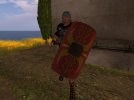Thanks Marcius - a pair of interesting articles - the conclusions of both leave the question, how was crucifixion actually done, very wide open - which allows for plenty of imaginative interpretations here on Crux Forums!
Cambridge article:
We must be hesitant to draw a general picture of crucifixion from these sources, but at least some of them testify to individuals carrying the patibulum towards the place of crucifixion. We may carefully assume a common knowledge in/around Rome, but how cross-bearing was rooted in practice in other parts of the Republic and early Empire is less certain. We still know very little about the patibulum, the range of its dimensions, or how it was fastened to either the condemned or the upright post. This shows how limited textual study is: people might have known exactly what crucifixion involved; how it was done might have ‘been in the air’ so to speak, but we are left with fragments and incomplete knowledge. It is vital to look further, not only to the non-Christian Greek sources which speak of carrying a σταυρός – which I intend to do elsewhere – but also to the reception of cross-bearing terminology of the Gospels in Early Christianity, which too may shed light on the cross-bearing sayings.
Brill article:
(1) Modern (re)constructions of how the beams of the cross were lifted and fastened to the already upright pole with slots and cavities, are unwarranted in ancient literature; no modern author refers to ancient evidence.
(2) Some ancient texts explicitly speak of nailing the beams together.
(3) Literary evidence shows different modes of crucifixion. The practice of crucifixion must have been more fluid than often is assumed and presented; this also pertains to the assumption that the vertical post was always already erected.
(4) The Gospel of Peter speaks of “erecting” the cross, which implies that it was lying down. If there was a patibulum, it seems likely that it would have been fastened while on the ground, like in Gibson’s The Passion of the Christ or other popular (cinematic) visualizations of crucifixion. This can lead to a fuller understanding of the gruesome reality of crucifixion.
(5) Literary evidence shows that individuals were nailed to a stake (ξύλον) while lying down. After that, they were erected. In view of the similarity of the punishments, at least regarding the terms used to describe them, this would be a likely alternative to attaching a patibulated victim onto/to an erected stipes.
(6) We still do not know how the whole cross with the crucified individual was raised. In general, ancient sources on crucifixion simply disclose nothing about how the cross was erected, lifted up, or secured into the ground. Nor do these ancient sources disclose how patibula were lifted up and subsequently fastened to an already standing pole.
(7) A possible by-effect of this study is that the Johannine use of ὑψόω is enriched; the term relating to crucifixion has a very practical component, namely the process of raising and fixing Jesus onto the cross.
Cambridge article:
We must be hesitant to draw a general picture of crucifixion from these sources, but at least some of them testify to individuals carrying the patibulum towards the place of crucifixion. We may carefully assume a common knowledge in/around Rome, but how cross-bearing was rooted in practice in other parts of the Republic and early Empire is less certain. We still know very little about the patibulum, the range of its dimensions, or how it was fastened to either the condemned or the upright post. This shows how limited textual study is: people might have known exactly what crucifixion involved; how it was done might have ‘been in the air’ so to speak, but we are left with fragments and incomplete knowledge. It is vital to look further, not only to the non-Christian Greek sources which speak of carrying a σταυρός – which I intend to do elsewhere – but also to the reception of cross-bearing terminology of the Gospels in Early Christianity, which too may shed light on the cross-bearing sayings.
Brill article:
(1) Modern (re)constructions of how the beams of the cross were lifted and fastened to the already upright pole with slots and cavities, are unwarranted in ancient literature; no modern author refers to ancient evidence.
(2) Some ancient texts explicitly speak of nailing the beams together.
(3) Literary evidence shows different modes of crucifixion. The practice of crucifixion must have been more fluid than often is assumed and presented; this also pertains to the assumption that the vertical post was always already erected.
(4) The Gospel of Peter speaks of “erecting” the cross, which implies that it was lying down. If there was a patibulum, it seems likely that it would have been fastened while on the ground, like in Gibson’s The Passion of the Christ or other popular (cinematic) visualizations of crucifixion. This can lead to a fuller understanding of the gruesome reality of crucifixion.
(5) Literary evidence shows that individuals were nailed to a stake (ξύλον) while lying down. After that, they were erected. In view of the similarity of the punishments, at least regarding the terms used to describe them, this would be a likely alternative to attaching a patibulated victim onto/to an erected stipes.
(6) We still do not know how the whole cross with the crucified individual was raised. In general, ancient sources on crucifixion simply disclose nothing about how the cross was erected, lifted up, or secured into the ground. Nor do these ancient sources disclose how patibula were lifted up and subsequently fastened to an already standing pole.
(7) A possible by-effect of this study is that the Johannine use of ὑψόω is enriched; the term relating to crucifixion has a very practical component, namely the process of raising and fixing Jesus onto the cross.





